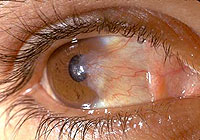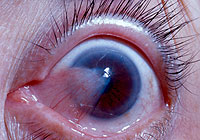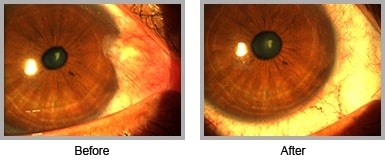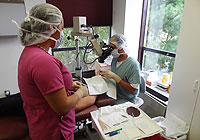
Welcome to the National Pterygium Institute. Dr. Babur Lateef has performed more than 1,000 pterygium surgeries and his surgical expertise is well recognized in the ophthalmology community. Dr. Lateef’s vast experience reduces the recurrence rate of pterygium and improves the cosmetic appearance after surgery. Take the first step and schedule a FREE consultation by contacting us at 703-491-EYES.
Pterygium is a benign growth of the conjunctiva, which is the lining of the white part of the eye. It often grows into the cornea, which covers the iris, or the colored part of the eye. A pterygium usually begins at the nasal side of the eye. It can be different colors, including red, pink, white, yellow or gray.

Patients with pterygium often initially become aware of the condition due to the appearance of a lesion on their eye or because they are bothered by a dry, itchy irritation, tearing or redness. Pterygium is usually first noticed when it is confined only to the conjunctiva. At this stage it is called a pingueculum. Once it extends to the cornea it is termed a pterygium and can eventually lead to impaired vision.
Causes
Although the causes of pterygium are not entirely known, it is believed to be caused mainly by exposure to UV light. Another suspected risk is living in a dry, dusty, windy environment. People who live near the equator or play water sports such as surfing and fishing may be more likely to develop pterygium. Prolonged exposure to these conditions causes the conjunctiva to thicken and the eye to become red and irritated. Collagen in the eye begins to deteriorate, and the eye weakens.
Studies show that there may also be a genetic predisposition to pterygium, with a higher prevalence in men than in women.

Signs and Symptoms
Symptoms of pterygium include dryness, redness, irritation, inflammation and tearing. In more severe cases, the pterygium may grow over the pupil and limit vision.
Prevention
Sunglasses that block UV rays, particularly sunglasses that provide side coverage, are a good means of protection against pterygium. Wearing a hat with a brim to block sunlight is also helpful. In hot, dry climates, artificial tears (eye drops) should be used to help lubricate the eyes.
Treatment

In most mild cases of pterygium, artificial tears can be used to reduce dryness and irritation.
For patients with severe cases whose vision has been affected, different types of surgery are available. Surgery is the only way to definitively remove a pterygium, but it is not a perfect solution; it requires long-term follow-up, and there is a risk that the pterygium will grow back.
Two of the main types of procedures performed to treat pterygium are:
- Conjunctival auto-grafting is a safe and effective technique that surgically removes a pterygium. In this procedure, the pterygium is removed along with the tissue covering the sclera (conjunctiva). Tissue is removed from the inside of the patient's upper eyelid and replaces the bare sclera.
- Amniotic membrane transplantation is another safe and effective pterygium removal procedure. Tissue is removed from the inner layer of the placenta and used to reconstruct the surface of the eye. This type of graft encourages healing and reduces swelling.
If the pterygium persists after surgery, or to minimize the risk of the pterygium recurring, a radiation treatment called strontium plaque therapy may be recommended. Radioactive strontium produces beta particles that penetrate the cornea and prevent the regrowth of blood vessels that develop as the pterygium returns.
To learn more about our Pterygium Services, please contact us at (703) 494-1766 today to schedule an appointment.


